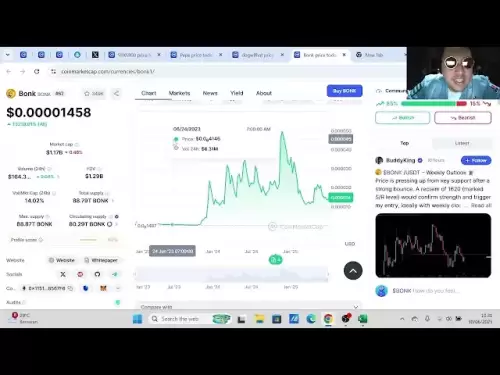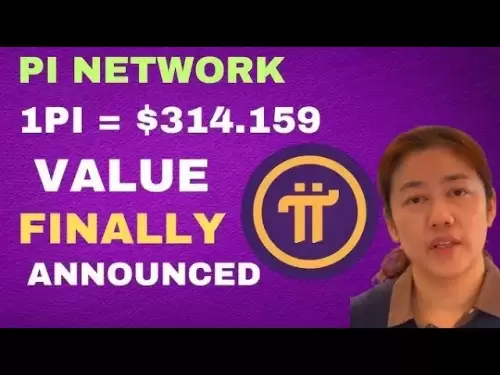-
 Bitcoin
Bitcoin $108,489.6704
1.13% -
 Ethereum
Ethereum $2,502.0528
2.92% -
 Tether USDt
Tether USDt $1.0002
0.00% -
 XRP
XRP $2.1941
0.51% -
 BNB
BNB $655.3375
1.00% -
 Solana
Solana $151.5977
1.27% -
 USDC
USDC $0.9999
0.00% -
 TRON
TRON $0.2768
0.32% -
 Dogecoin
Dogecoin $0.1676
2.86% -
 Cardano
Cardano $0.5675
0.98% -
 Hyperliquid
Hyperliquid $40.6109
7.48% -
 Bitcoin Cash
Bitcoin Cash $500.7746
2.09% -
 Sui
Sui $2.8328
2.03% -
 Chainlink
Chainlink $13.4452
1.26% -
 UNUS SED LEO
UNUS SED LEO $9.1623
0.39% -
 Avalanche
Avalanche $18.2267
2.24% -
 Stellar
Stellar $0.2382
0.00% -
 Toncoin
Toncoin $2.8885
1.68% -
 Shiba Inu
Shiba Inu $0.0...01159
0.91% -
 Litecoin
Litecoin $87.1827
0.88% -
 Hedera
Hedera $0.1511
2.90% -
 Monero
Monero $315.4992
-0.59% -
 Polkadot
Polkadot $3.4663
2.34% -
 Bitget Token
Bitget Token $4.6118
-0.65% -
 Dai
Dai $1.0000
-0.01% -
 Ethena USDe
Ethena USDe $1.0003
0.02% -
 Uniswap
Uniswap $7.2989
4.69% -
 Pepe
Pepe $0.0...01003
5.73% -
 Aave
Aave $275.5616
7.15% -
 Pi
Pi $0.5181
-2.49%
How to identify a CORE false breakout? How to accurately draw support and resistance lines?
Identifying CORE false breakouts in crypto trading involves watching volume, breakout duration, and price action around key levels to avoid unnecessary losses.
May 07, 2025 at 11:29 am
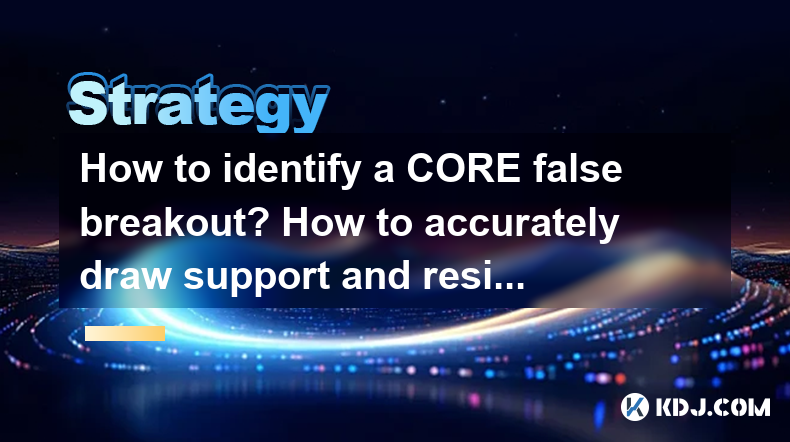
Understanding CORE False Breakouts
Identifying a CORE false breakout is crucial for traders in the cryptocurrency market as it can help prevent unnecessary losses and improve trading strategies. A CORE false breakout occurs when the price of a cryptocurrency appears to break through a significant support or resistance level but quickly reverses direction, failing to sustain the breakout. To accurately identify a CORE false breakout, traders must pay close attention to several key indicators and patterns.
Volume is a primary indicator to watch. During a genuine breakout, trading volume typically increases significantly as more traders enter the market. Conversely, a false breakout often occurs with relatively low volume, suggesting a lack of strong market interest. If the price breaks through a support or resistance level but the volume does not increase, it could be a sign of a false breakout.
Another important factor is the duration of the breakout. A genuine breakout should show sustained movement beyond the support or resistance level. If the price quickly reverses back within a short period, it is likely a false breakout. Traders should monitor the price action closely after a breakout occurs, looking for signs of reversal such as doji candles, shooting stars, or hammers, which can indicate a potential false breakout.
Price action around the breakout level can also provide valuable insights. If the price hesitates or shows multiple attempts to break through a level without success, it may indicate a false breakout. Traders should observe how the price behaves around the support or resistance level, noting any signs of rejection or failure to sustain the breakout.
Drawing Accurate Support and Resistance Lines
Accurately drawing support and resistance lines is essential for identifying potential breakout points and false breakouts. These lines are horizontal levels on a price chart that indicate where the price has historically faced significant buying or selling pressure. To draw these lines accurately, traders should follow a systematic approach.
Begin by identifying historical price levels where the price has repeatedly reversed direction. These levels can be found by examining past price data and looking for areas where the price has bounced off multiple times. For example, if the price of a cryptocurrency has bounced off a particular level three or more times, it is likely a strong support or resistance level.
Next, use a charting tool to draw a horizontal line at these identified levels. Ensure that the line is drawn precisely at the point where the price has reversed, as even a slight deviation can affect the accuracy of the analysis. It is also important to consider the timeframe of the chart; support and resistance levels on a daily chart may differ from those on a weekly or monthly chart.
Validate the lines by observing how the price interacts with them over time. If the price continues to respect the drawn lines, it confirms their validity. However, if the price breaks through a line without significant volume or quickly reverses, it may be necessary to adjust the line or consider it invalid.
Using Multiple Timeframes for Analysis
To enhance the accuracy of identifying CORE false breakouts and drawing support and resistance lines, traders should incorporate multiple timeframes into their analysis. Different timeframes can provide different perspectives on market trends and price movements, helping to confirm or refute potential breakouts and levels.
Start with a longer timeframe, such as a weekly or daily chart, to identify the major support and resistance levels. These levels are typically more significant and can provide a broader view of the market's direction. Once the major levels are identified, move to a shorter timeframe, such as an hourly or 15-minute chart, to observe how the price interacts with these levels in real-time.
By comparing the price action across different timeframes, traders can gain a more comprehensive understanding of the market dynamics. For instance, if a breakout appears on a shorter timeframe but is not confirmed on a longer timeframe, it could indicate a false breakout. Similarly, if a support or resistance level is respected across multiple timeframes, it strengthens the validity of that level.
Incorporating Technical Indicators
Technical indicators can provide additional confirmation when identifying CORE false breakouts and drawing support and resistance lines. Indicators such as moving averages, the Relative Strength Index (RSI), and the Moving Average Convergence Divergence (MACD) can help traders gauge market momentum and potential reversal points.
For example, if the price breaks through a resistance level but the RSI is in overbought territory, it could signal a false breakout. Similarly, if the MACD shows divergence from the price action, it may indicate that the breakout lacks momentum and is likely to fail.
When drawing support and resistance lines, traders can use moving averages to identify dynamic levels of support and resistance. For instance, a 50-day moving average can act as a dynamic support level, while a 200-day moving average can serve as a dynamic resistance level. By incorporating these indicators into their analysis, traders can enhance the accuracy of their support and resistance lines.
Practical Steps for Identifying CORE False Breakouts
To practically identify a CORE false breakout, traders can follow these steps:
- Identify key support and resistance levels on the chart using historical price data.
- Monitor the price as it approaches these levels, looking for signs of a potential breakout.
- Observe the volume during the breakout. If the volume is low, it could indicate a false breakout.
- Check the duration of the breakout. If the price quickly reverses after breaking through a level, it is likely a false breakout.
- Analyze price action around the breakout level, noting any signs of rejection or failure to sustain the breakout.
- Use technical indicators such as RSI and MACD to confirm the breakout or identify potential reversal points.
Practical Steps for Drawing Support and Resistance Lines
To draw accurate support and resistance lines, traders can follow these steps:
- Examine historical price data to identify levels where the price has repeatedly reversed direction.
- Use a charting tool to draw horizontal lines at these identified levels, ensuring precision in placement.
- Validate the lines by observing how the price interacts with them over time. Adjust or invalidate lines as necessary.
- Incorporate multiple timeframes to confirm the validity of the levels across different charts.
- Use technical indicators such as moving averages to identify dynamic support and resistance levels.
Frequently Asked Questions
Q: How can I differentiate between a genuine breakout and a false breakout in a volatile market?
A: In a volatile market, differentiating between genuine and false breakouts can be challenging. One effective approach is to focus on volume and price action. A genuine breakout is typically accompanied by high volume and sustained price movement beyond the breakout level. In contrast, a false breakout often occurs with low volume and quick price reversals. Additionally, using multiple timeframes and technical indicators can provide further confirmation of the breakout's validity.
Q: Can support and resistance levels change over time, and how should I adjust my lines accordingly?
A: Yes, support and resistance levels can change over time as market conditions evolve. Traders should regularly review and adjust their lines based on new price data and market trends. If a previously identified level is broken with significant volume and sustained price movement, it may be necessary to redraw the line at the new level. Additionally, incorporating multiple timeframes can help identify shifts in support and resistance levels more accurately.
Q: What role does market sentiment play in identifying false breakouts?
A: Market sentiment can significantly influence the occurrence of false breakouts. If the market sentiment is overly optimistic or pessimistic, it can lead to exaggerated price movements that may not be sustainable. Traders should monitor market sentiment indicators such as the Crypto Fear & Greed Index or social media sentiment analysis tools to gauge the overall mood of the market. If sentiment is extreme, it could increase the likelihood of false breakouts, as the market may be prone to sudden reversals.
Q: Are there specific candlestick patterns that can help identify false breakouts more accurately?
A: Yes, certain candlestick patterns can provide valuable insights into potential false breakouts. Patterns such as doji, shooting stars, and hammers often indicate indecision or reversal in the market, which can signal a false breakout. For example, if a doji candle forms immediately after a breakout, it suggests that the market is unsure about the breakout's validity, increasing the likelihood of a false breakout. Traders should combine these candlestick patterns with other indicators and volume analysis for more accurate identification of false breakouts.
Disclaimer:info@kdj.com
The information provided is not trading advice. kdj.com does not assume any responsibility for any investments made based on the information provided in this article. Cryptocurrencies are highly volatile and it is highly recommended that you invest with caution after thorough research!
If you believe that the content used on this website infringes your copyright, please contact us immediately (info@kdj.com) and we will delete it promptly.
- Ripple, Stablecoin, Adoption: RLUSD Leading the Charge
- 2025-06-30 14:30:12
- Bitcoin ETF, IBIT, and the Bull Flag: Is $144,000 on the Horizon?
- 2025-06-30 14:50:12
- Bitcoin, Passive Income, and a Bull Raise: Riding the Crypto Wave
- 2025-06-30 14:30:12
- Bitcoin, Personal Loans, and Omega 88: A New Era in Lending?
- 2025-06-30 15:09:14
- Saylor's Strategy: How MicroStrategy's Bitcoin Bet is Reshaping Finance
- 2025-06-30 14:52:14
- Metaplanet's Bitcoin Blitz: From Zero to Hero in the Corporate Treasury Race
- 2025-06-30 15:10:54
Related knowledge

What are the skills of Bitcoin option hedging? Practical case sharing
Jun 24,2025 at 04:01pm
Understanding Bitcoin Option HedgingBitcoin option hedging is a risk management strategy used by traders and investors to protect their positions in the volatile cryptocurrency market. By using options, individuals can limit potential losses while retaining the opportunity for profit. In essence, it allows one to insulate against adverse price movements...
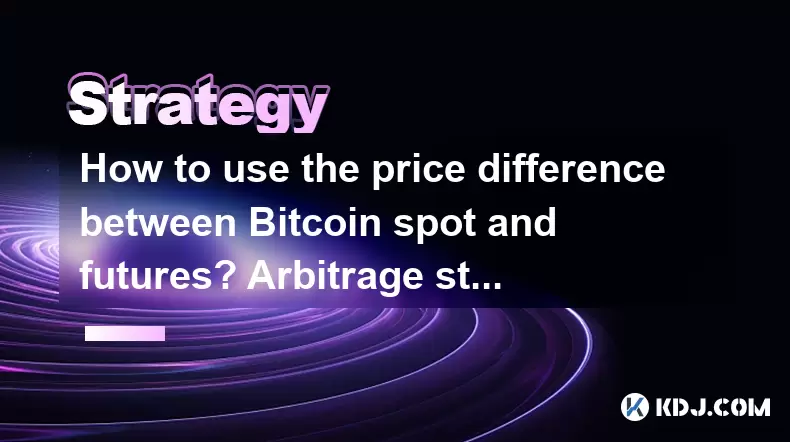
How to use the price difference between Bitcoin spot and futures? Arbitrage strategy
Jun 20,2025 at 02:56pm
Understanding Bitcoin Spot and Futures MarketsTo effectively leverage arbitrage opportunities between Bitcoin spot and futures markets, it's essential to understand the fundamental differences between these two types of markets. The spot market refers to the direct buying and selling of Bitcoin for immediate delivery at the current market price. In cont...

How to increase DeFi lending income? Strategy and risk analysis
Jun 24,2025 at 02:08pm
Understanding DeFi Lending and Its Income PotentialDeFi (Decentralized Finance) lending has emerged as a popular way to earn passive income in the cryptocurrency space. Unlike traditional banking systems, DeFi lending platforms allow users to lend their crypto assets directly to borrowers without intermediaries. The lenders earn interest based on the su...

How to operate cryptocurrency cross-market arbitrage? Practical analysis
Jun 23,2025 at 04:01am
Understanding Cryptocurrency Cross-Market ArbitrageCryptocurrency cross-market arbitrage involves taking advantage of price differences for the same digital asset across different exchanges. The core idea is to buy low on one exchange and sell high on another, capturing the profit from the discrepancy. This strategy relies heavily on real-time market da...

How to make profits from high-frequency cryptocurrency trading? Sharing core skills
Jun 19,2025 at 05:07pm
Understanding High-Frequency Cryptocurrency TradingHigh-frequency trading (HFT) in the cryptocurrency market involves executing a large number of trades at extremely fast speeds, often within milliseconds. This method relies on small price discrepancies across exchanges or within a single exchange’s order book. Traders use complex algorithms and ultra-l...
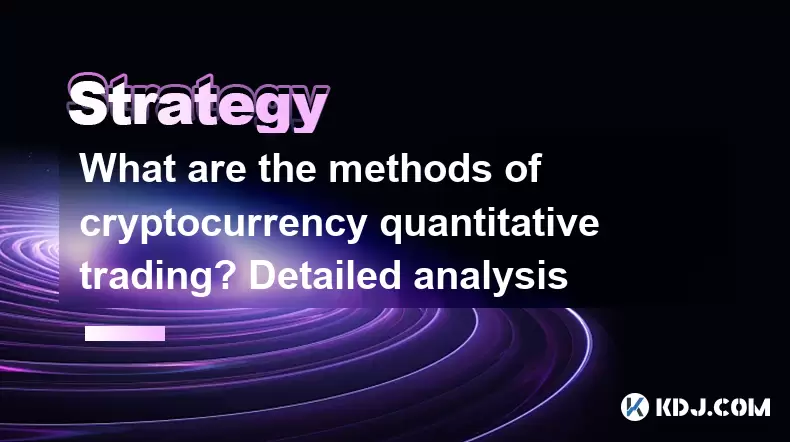
What are the methods of cryptocurrency quantitative trading? Detailed analysis
Jun 22,2025 at 11:07pm
Understanding the Core of Cryptocurrency Quantitative TradingCryptocurrency quantitative trading refers to the use of mathematical models and algorithms to execute trades in the digital asset market. Unlike traditional discretionary trading, which relies heavily on human judgment, quantitative trading leverages data-driven strategies to identify profita...

What are the skills of Bitcoin option hedging? Practical case sharing
Jun 24,2025 at 04:01pm
Understanding Bitcoin Option HedgingBitcoin option hedging is a risk management strategy used by traders and investors to protect their positions in the volatile cryptocurrency market. By using options, individuals can limit potential losses while retaining the opportunity for profit. In essence, it allows one to insulate against adverse price movements...

How to use the price difference between Bitcoin spot and futures? Arbitrage strategy
Jun 20,2025 at 02:56pm
Understanding Bitcoin Spot and Futures MarketsTo effectively leverage arbitrage opportunities between Bitcoin spot and futures markets, it's essential to understand the fundamental differences between these two types of markets. The spot market refers to the direct buying and selling of Bitcoin for immediate delivery at the current market price. In cont...

How to increase DeFi lending income? Strategy and risk analysis
Jun 24,2025 at 02:08pm
Understanding DeFi Lending and Its Income PotentialDeFi (Decentralized Finance) lending has emerged as a popular way to earn passive income in the cryptocurrency space. Unlike traditional banking systems, DeFi lending platforms allow users to lend their crypto assets directly to borrowers without intermediaries. The lenders earn interest based on the su...

How to operate cryptocurrency cross-market arbitrage? Practical analysis
Jun 23,2025 at 04:01am
Understanding Cryptocurrency Cross-Market ArbitrageCryptocurrency cross-market arbitrage involves taking advantage of price differences for the same digital asset across different exchanges. The core idea is to buy low on one exchange and sell high on another, capturing the profit from the discrepancy. This strategy relies heavily on real-time market da...

How to make profits from high-frequency cryptocurrency trading? Sharing core skills
Jun 19,2025 at 05:07pm
Understanding High-Frequency Cryptocurrency TradingHigh-frequency trading (HFT) in the cryptocurrency market involves executing a large number of trades at extremely fast speeds, often within milliseconds. This method relies on small price discrepancies across exchanges or within a single exchange’s order book. Traders use complex algorithms and ultra-l...

What are the methods of cryptocurrency quantitative trading? Detailed analysis
Jun 22,2025 at 11:07pm
Understanding the Core of Cryptocurrency Quantitative TradingCryptocurrency quantitative trading refers to the use of mathematical models and algorithms to execute trades in the digital asset market. Unlike traditional discretionary trading, which relies heavily on human judgment, quantitative trading leverages data-driven strategies to identify profita...
See all articles























